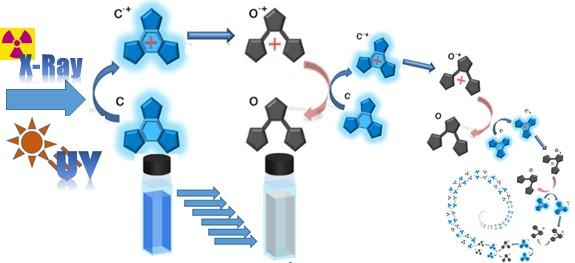Feb 10 2020
Researchers from Nara Institute of Science and Technology (NAIST), Ikoma, Japan, and Centre National de la Recherche Scientfique (CNRS), Toulouse, France, have developed a new reaction system with the ability to detect X-rays at the highest sensitivity ever known by using organic molecules.
 The hazardous radiations such as ultraviolet and X-ray oxidative triggers the color-changing cascade of new dyes for 1000 times. Image Credit: Tsuyoshi Kawai.
The hazardous radiations such as ultraviolet and X-ray oxidative triggers the color-changing cascade of new dyes for 1000 times. Image Credit: Tsuyoshi Kawai.
The system performs the cycloreversion of terarylene, making the molecule to shift reversibly between blue and colorless isoforms when X-rays are present or absent. This reaction system carried out detection at safe doses, and hence is anticipated to detect even the most feeble X-ray levels regarded as hazardous.
Photoreactive materials have the ability to convert input light into chemical output. They are commonly used in 3D printing and semiconductor technologies. A few of these materials are also employed in eye-protection, for example, the way sunglasses minimize UV exposure by changing the lens color. Likewise, workers prone to X-ray radiation must wear monitoring badges that signal hazardous levels through variations in photoreactive materials.
But Tsuyoshi Kawai, a NAIST Professor, emphasized that these badges do not avoid the risk totally.
Current materials for wearable detectors are sensitive to about 1 Gy. Ideally, safety management systems want about one hundred times more sensitivity.
Tsuyoshi Kawai, Professor, Nara Institute of Science and Technology
Kawai specializes in boosting the photoconversion efficiency of photoreactive molecules, with a main focus on terarylenes—organic molecules using which his research group has consistently realized remarkably high reaction efficiencies.
We have steadily improved the number of molecules that can undergo photoconversion in response to one photon. It was one to one in 2011 and today it becomes 33 molecules per one photon.
Tsuyoshi Kawai, Professor, Nara Institute of Science and Technology
The quantum yield of terarylenes can be increased by maximizing the number of changes that can be initiated by a single photon. Terarylenes were chosen for their reversibility, that is, it is possible to convert the molecule back to the original blue isoform by exposing it to ultraviolet light, thereby enabling the system to be reset for repeated use.
In fact, the change in color is one of the various reasons he considers organic molecules are preferred when it comes to X-ray detectors.
Photochromic organic detectors can report X-rays through easily observed color changes and are recyclable and easy to process.
Tsuyoshi Kawai, Professor, Nara Institute of Science and Technology
The terarylene molecules were modified mainly by adding a phenyl group to just one of the molecules of the two phenylthiophene groups. Thus, reversible photoconversion between the two isoforms was possible. The outcome was a sensitivity of nearly 0.3 Gy, rendering it over 1000 times more sensitive compared to existing commercial systems. Specifically, 0.3 Gy is regarded as a safe exposure level, implying that no dangerous level will go unnoticed.
Photoconversion reactions such as neural stimulation in response to light in human eyes or photosynthesis occur at an efficiency of <100% (less than one molecule responds to one photon). By contrast, the system developed by the team was able to achieve 3300% (33 molecules per photon), demonstrating the potential of organic molecules in artificial systems.
“I think this is the highest efficiency ever reported for photoconversion with an organic molecule,” added Kawai.